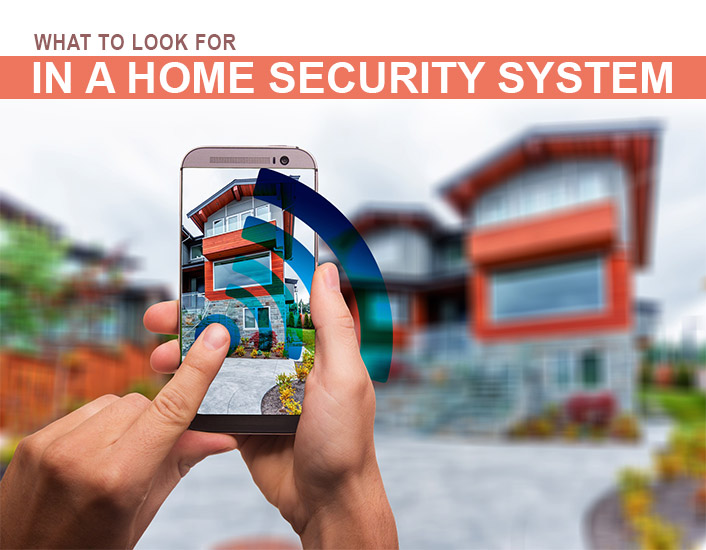Home security is an important factor that contributes to good health and peace of mind. You want to make sure that your family is free from any form of danger 24/7. Home security systems have been used for several decades and the earliest systems featured a closed-circuit television system, remote-controlled door, and two-way communication. Nowadays, there are thousands of options in the market, from DIY kits to more complex systems built into your home. How to choose? And what are the important features to look for in a home security system? Here, we will help you understand your options and which features you should consider before buying a security system.
The first step to finding the best security system that will meet your needs is to determine what you want to protect and what kind of services you require. Modern security systems can do more than keep burglars and intruders away. They can also communicate with family members that are left at home and monitor your property for electrical concerns and probable catastrophes. Let’s take a look at the 3 main types of security system packages available today.
Types of Security Systems:
Security Equipment
If you are worried about theft, intrusion, or vandalism, a traditional home security system will have the security equipment to help ease your distress. It includes basic security devices like burglar alarms, glass break detectors, and outdoor surveillance cameras.
Environmental Monitoring
On top of providing a home alarm and theft protection, environmental monitoring systems help you prevent frozen pipes, flooding, and damages caused by high-humidity. It can detect system operation and malfunction and can automatically turn off hazardous equipment in your home.
Smart Home Automation
A home automation system controls your home’s lighting, appliances, and climate. It also consists of security features such as alarm systems and access control. The system connects all its controlled devices to the central hub, also known as the gateway. Connecting it to the internet will enable you to access your home through your computer or smartphone when you are far from home. Additionally, a smart home automation system adjusts to your family’s schedule and preferences.
An ideal home security system will incorporate the functions of these three systems. You may also connect your devices wired, wireless or both. Unfortunately, having it all could get pretty expensive. The best way to get the most features with a workable budget is to determine which ones your home will need. Security providers bundle devices differently so, it’s best to mind your priorities when checking security packages. Below is a list of the top features available from most providers and what to look for in a home security system.
1. Professional Monitoring
This feature connects your system to a professional call centre that can contact emergency services on your behalf. Time is important during an emergency. Professional monitoring quickly responds to your need and could save someone’s life
2. Two-Way Communication
Two-way communication can turn your device into an intercom. You can speak and listen through, which works great for checking on young children and identifying visitors before you allow entry to your home. Find a device that also provides a camera so you can see and confirm who you’re talking to. This will also allow you to talk to the mailman and catch package thieves.
3. Security Camera Systems
Security cameras and video surveillance are very useful when it comes to home security. They help deter theft and crime, allow you to monitor activities in your house when you are away. This way, you can check on your children, caregivers, aging parents, and pets while you are away.
4. Motion Sensors And Motion Detection Lights
This feature alerts you for suspicious activity in your home and lights up the area where it senses movement. This feature is good for catching intruders and sneaky teenagers. You will also be able to identify them right away. Some providers offer motion sensors and motion detection lights separately. It is ideal for both to work together.
5. Panic Button
Panic buttons provide instant communication to emergency services. It works best for aging people and those who have disabilities and severe health conditions.
6. Glass Break Sensor
Glass break sensors alert you of broken glass in case of break-ins. An intruder who enters through breaking your window glass will think of backing out from his plan when he hears the loud alarm.
7. Smart Home Integration
This combines the strength of your security system with your smart home devices. It allows your system to be voice-controlled and adjust to your family’s routines and preferences.
8. Fire and Smoke Alarm
Temperature sensors and smoke detectors will alert you and help prevent a fire from destroying your property and endangering your family’s health.
9. Remote Door Access
The ability to remotely lock and unlock your doors might come in handy at some point, especially if you are away from home. This will allow you to grant access to your family members during lockout situations. Also, you can protect your home by remotely locking the doors in case they are accidentally left open.
10. Environmental Sensors
Environmental sensors include Carbon Monoxide (CO), flood, freeze, and humidity detectors. They help prevent loss and damages caused by gas leaks, plumbing issues, temperature drops, and other natural home threats.
Other features could also help you with your home security system needs. Identify your options on what to look for in a home security system. Just keep in mind that your security is your main purpose. Keep your priorities on top of other sophisticated features you might not need.
